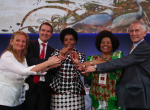 4 October 2016: For eleven days in Johannesburg, South Africa, Parties to the Convention on International Trade in Endangered Species of Wild Fauna and Flora (CITES) and many other stakeholders convened for the seventeenth meeting of the Conference of the Parties (CoP17) to consider 200 documents, including 62 proposals submitted by 64 countries to amend CITES Appendices. The Convention highlighted the participation of 152 governments and 3,500 people, making the meeting the largest CITES CoP and the first where the European Union participated and voted as a Party to the Convention.
4 October 2016: For eleven days in Johannesburg, South Africa, Parties to the Convention on International Trade in Endangered Species of Wild Fauna and Flora (CITES) and many other stakeholders convened for the seventeenth meeting of the Conference of the Parties (CoP17) to consider 200 documents, including 62 proposals submitted by 64 countries to amend CITES Appendices. The Convention highlighted the participation of 152 governments and 3,500 people, making the meeting the largest CITES CoP and the first where the European Union participated and voted as a Party to the Convention.
The CITES CoP adopted a novel resolution on corruption and wildlife crime and as well as on cybercrime as it relates to illegal trade in CITES-listed species. The CoP adopted a resolution on strategies to reduce demand for illegally traded fauna and flora. The Parties also agreed on measures to expand participation, adopting decisions to support youth engagement and to encourage rural communities’ and local peoples’ roles in wildlife management. In addition, Parties agreed to improve the traceability and identification of CITES-listed species as well as processes to ensure sustainable wildlife trade.
With regard to Southern African elephants, Parties decided to stay with the status quo split listing. Elephant populations in Botswana, Namibia and Zimbabwe fall under Appendix II, while others are listed under Appendix I. Parties at CoP17 also agreed to close domestic markets in ivory where they contribute to poaching or illegal trade and rejected a Decision-Making Mechanism (DMM) for future ivory trade. This closing of discussions on the DMM frustrated some southern African countries that had agreed to a nine-year moratorium, which ends in 2017, on ivory trade proposals on the condition that a DMM would be developed. Next year, Parties can put forward legal ivory trade proposals in the absence of an agreed-upon DMM, which suggests the polarized debates on the elephant crisis will continue at future CoPs.
The meeting also took decisions affecting trade in a number of other CITES-listed species. Parties voted to transfer the African grey parrot and all eight species of pangolin from Appendix II to Appendix I, prohibiting all international commercial trade in wild taken specimens. They listed several previously controversial shark and ray species, as well as the entire genus of rosewood, on Appendix II. Other decisions offered greater protection and understanding of trade as it impacts the helmeted hornbill, the vaquita, cheetahs, agarwood-producing taxa and ebonies. Participants also recognized several conservation success stories, including that of the Cape mountain zebra, several species of crocodiles and the wood bison, which were all downlisted by consensus from Appendix I to Appendix II in recognition of their improved conservation status.
CITES referred to the meeting, which concluded a day early, as a “game changer.” The Convention’s Secretary-General John Scanlon said of the meeting’s spirit, that “although we were all drumming in a slightly different way, we were all drumming to the same beat.” CITES convened in Johannesburg, South Africa from Saturday, 24 September through Tuesday, 4 October 2016. The eighteenth meeting of the CoP will be held in Sri Lanka in 2019. [IISD RS Coverage of CITES CoP17] [CITES Press Release]